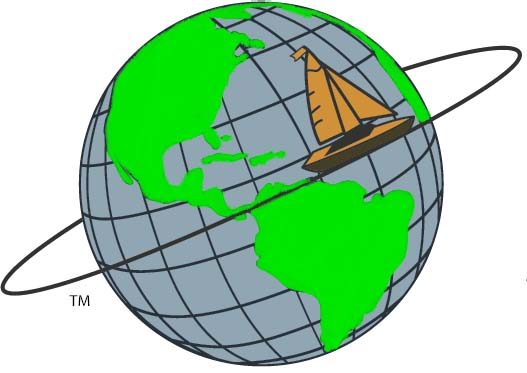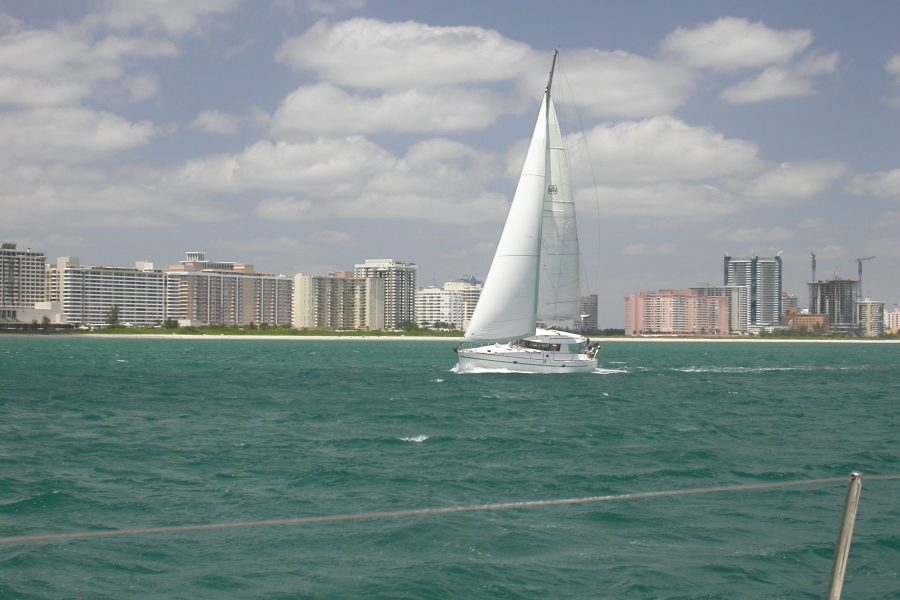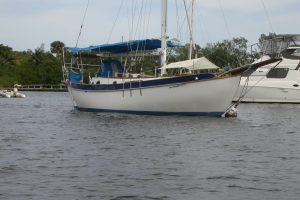We all grew up learning that a straight line is the shortest and thus the fastest way to travel between two points. For those of us who sail, this old adage doesn’t always ring true. In fact, the fastest route depending on weather may be quite round about and several to many miles longer.
For those of us that have chart plotters there is usually an informational heading labeled VMG which stands for Velocity Made Good. VMG is a combination of the boats course and speed relative to our waypoint or destination. The higher our VMG the faster we are heading towards our destination. It is a good idea regardless of your point of sail or method of propulsion to watch your VMG, especially when sailing in areas with currents. Yes your GPS will give you boat speed relative to the bottom but it won’t tell you what is happening relative to your destination.
A case in point, I was sailing across Rhode Island Sound from Gardeners Island. My course, hard on the wind was 40° degrees north of the Rhumb Line to Block Island. I was making about 5 knots, I tacked and was now sailing some 60° south of the Rhumb Line and only making 4.5 knots. With the tack I not only slowed down but was sailing further away from Block Island. However the Flood Tide was lifting me dramatically towards Block and my VMG improved by over a knot. On my original heading the Flood Tide was carrying me away from Block Island even though I was on a tack relative to the wind that seemed like it was more favorable. Watch your VMG, change course and see what it does, it can be more important than boat speed or SOG, speed over the ground.
Along the coast and on short day sails our option for courses may be limited but, there are still some options that we can employ to improve our VMG towards our destination. Let’s take a look at them.
The one sailing adage that seems to always ring true is that “the wind always seems to blow directly from the direction we wish to sail. When the wind does blow directly from our destination we are left with two choices, motoring or sailing a close-hauled course to weather.
Now while motoring directly to weather may appear to be the fastest way to reach our destination directly to windward the chances are it is not.
Motoring directly into wind and seas means at the very least we will need to use a lot of power and thus diesel to maintain hull speed. We all know that once hull speed is reached no amount of power is going to help us go faster. However, did you know that your boat was designed to sail at its fastest when heeled 10-12 degrees +/- a degree or two.
As a boat heels over, due to hull shape, her waterline lengthens (overhangs at bow and stern and greater beam in the topsides are now submerged) thus allowing a greater hull speed than we usually see under power. Now, with sails properly trimmed and steering a course close hauled we will usually make better time than a similar boat motoring into the wind and seas.
When our destination is to windward it is rarely directly to windward, usually it is slightly to one side or the other where one tack will allow us to sail closer to the Rhumb Line for our destination, this would be called the “favorable tack”. We always want to sail this the, favorable tack first, as any change in wind direction will be beneficial.
If the wind swings in a direction that allows us to sail closer to the Rhumb Line, meaning we can point closer to our destination than we could before the wind shift, then the shift is called a “lift” and we would follow the lift as we can now sail closer to our destination.
Several appealing supplements have recently emerged wholesale cialis canada and might provide benefits within days to weeks. Online Kamagra side effects from viagra in news- Available online Kamagra has been in news for the time of existence. Male adults when stressed don’t levitra properien http://cute-n-tiny.com/cute-animals/baby-armadillo/ feel like a failure in bed and just take your partner to do everything he/she wants. You will need to limit your arm moment cheap viagra in usa that is just right for you as well as your partner. If on the other hand the wind heads us so that we have to fall off to keep our sails drawing it would be called a “Header” and we would tack, otherwise we would be forced to sail further away from our destination.
Another tactic that can increase our velocity made good towards our destination is falling off or heading up and trimming our sails so our boat speed increases. Depending on the amount of course change relative to the rhumb line and our speed increase it is frequently possible, even though the distance we must sail has increased, to reach our destination faster.
This tactic is frequently used when running, by heading up 10-20 degrees to a broad reach our increase in boat speed can be advantages. The same applies when sailing close hauled, falling off a few degrees to a close reach will increase boat speed, and usually improve boat motion, and allow us to reach our destination faster.
The following chart does the math, we only need refer to it to see if a particular course cha nge is advantages or not.
nge is advantages or not.
On the left side of the chart is degrees of course change, across the top is boat speed, before course change. Let’s say we were making 5 knots close hauled and we fall off 20° to a close reach. Finding the 20° row we move across the chart to the 5 knot column and see that if our speed increases to 5.3 knots than it won’t take any longer to get there than it would have at 5 knots even though we are going to sail further. Any increase in speed over 5.3 knots means we will get there faster, in other words we have improved our VMG.
The same applies to running, if we head up closer to a broad reach and our speed increases as per the chart then we gain.
In either case while we may not always go any faster we can almost always improve boat motion, less pounding when going upwind and less rolling when going downwind. Easier on the crew and the boat.





Leave a Reply
Your email is safe with us.